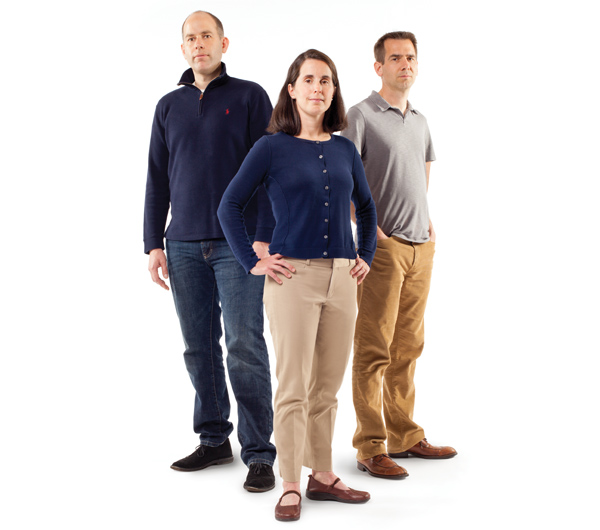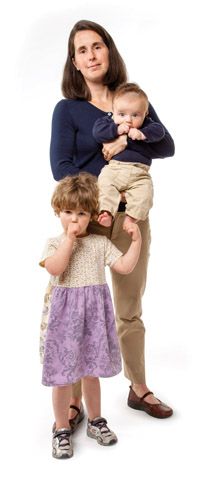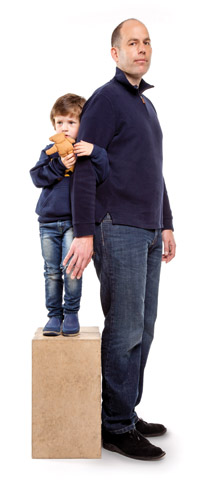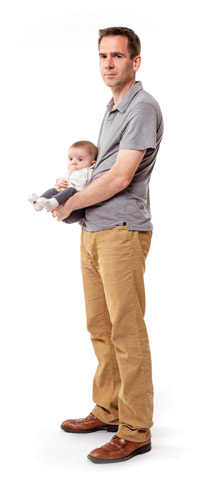
NOT JUST ACADEMIC: In his inaugural speech this January, President Obama said that a failure to respond to climate change “would betray our children and future generations.” Meredith Fowlie, Max Auffhammer, and Wolfram Schlenker, pictured above (center, left, and right), and also below with their young children, may have troubling research findings on the topic, but they are all stakeholders in finding meaningful solutions.
Why Are These Climate Change Experts Worried About Their Kids’ Futures?
“Everybody complains about the weather, but nobody does anything about it,” the writer Charles Dudley Warner said (though the famous quotation is often misattributed to his friend Mark Twain). But as climate change causes global temperatures to rise, people may be forced to take action — even in the United States, where resistance to measures that would reduce carbon emissions has been strong. Last year the country sweltered through its third hottest summer since record keeping began in 1895. Outbreaks of wildfire in Colorado dominated the nightly TV news, and newspapers carried dramatic headlines about the plight of farmers in the Midwest, who suffered through what the U.S. Department of Agriculture called the most severe and extensive drought in at least 25 years.
“We’ve constructed an entire civilization on a set of assumptions about how nature’s going to behave, and those assumptions are no longer good.”
Andrew Guzman
Along with an increase in the virulence of superstorms that in recent years have paralyzed New Orleans, New York, and Boston, the drought seemed to sharpen the American public’s concern about rising global temperatures. It was likely a harbinger of the future. “Whether the drought last summer was really due to climate change or not is sort of beside the point,” says Max Auffhammer, an associate professor in UC Berkeley’s Department of Agricultural and Resource Economics (ARE). “What we’ve got is a good example of a really, really hot summer. A lot of models are predicting that that’s what most summers will look like by the end of the century.”
Auffhammer isn’t alone in his assessment that climate change has arrived. And scientists and economists working on the issue agree that while mitigation — reducing or preventing greenhouse gas emissions — is important, it is only a part of the picture for a problem that has no immediate solution. “While we should engage in mitigation because less climate change is better, we need to also be focusing on adaptation strategies,” Auffhammer says.
There is also a growing consensus — one we fail to acknowledge at our peril — that any serious analysis of climate change must take into account its human and economic toll worldwide, in particular the effects of people moving out of or into poverty.
Limiting the Damage
Many countries have informally agreed that it’s important to limit global temperature increases to two degrees Celsius (3.6 degrees Fahrenheit). But halting warming to even two degrees will cause plenty of fallout.
“Two degrees is enough to cause major, major disruption in the way we live, and to negatively impact billions of people on the planet,” says Andrew Guzman, a UC Berkeley law professor and author of the recent book Overheated: The Human Cost of Climate Change. “We’ve constructed an entire civilization on a set of assumptions about how nature’s going to behave, and those assumptions are no longer good.”
Physical infrastructure that we take for granted, such as farm and water-delivery systems, “isn’t built for [the stresses of climate change], and some of those systems might not withstand them.” Guzman found that climate change could not only wreak havoc on infrastructure like California’s massive water-supply system, but could also set bigger geopolitical tremors in motion. Chronic drought in Pakistan, for instance, could very likely lead to a nuclear showdown between that country and India, which occupies a strategically superior spot on the Indus River.
Auffhammer, who serves on the Intergovernmental Panel for Climate Change (IPCC), agrees that the future could be desperate: “If we keep going at the rate we’re going, it really is a complete change of what the world looks like.”
The international effort to cap and reduce greenhouse gas emissions has stalled out, and that has only made odds worse. “Even if we abandon the two-degree goal,” says Auffhammer, “we still have to work very, very hard to make sure we limit it to three- to four-degree warming.”
“The ideal response to a global environmental problem such as climate change is a coordinated global policy response, but this is unlikely to happen any time soon,” says Meredith Fowlie, an ARE assistant professor who earned her Ph.D. from that department in 2006. “Anything that’s politically palatable is not going to do the trick, at least in the near term.”
In the face of such planetary-scale paralysis, Fowlie and other researchers on the front lines of the climate problem are contemplating the consequences of a stitched-together patchwork of measures to stem, and adapt to, global warming. Farmers will have to find ways to cope with rising temperatures and increasing water scarcity. Many rural and suburban communities will have to prepare for more frequent and more severe wildfires. Low-lying coastal cities will have to buttress themselves against rising sea levels and more powerful hurricanes, or abandon swaths of flood-prone land. In New York, for instance, Gov. Andrew Cuomo is proposing to buy homes destroyed by Hurricane Sandy and put those areas off-limits to future development.
Adaptation’s Downside
But the quest to adapt to climate change is complicated by the fact that large parts of the world are, as Auffhammer puts it, “pulling people out of poverty at unprecedented speed,” improving their quality of life — and dramatically increasing their carbon footprints as they do so. “As economists, we recognize that greenhouse gas emissions have brought wealth, health, and other benefits, but at a cost,” he says.
And we may be creating a host of new problems as we adapt to rising temperatures. For example, Auffhammer is currently studying the spread of air conditioning in China. As temperatures — and incomes — have risen there, so have the number of air conditioning units. He found that the number of air conditioners in Shanghai grew from 0.33 per household in 1995 to almost two per household in 2009.
“People adapt,” he says — for better or for worse. More widespread use of air conditioning can dramatically reduce heat-related mortality, but that comes with a major downside. “The amount of energy you need to power that amount of cooling during hot days is significant. A 100-degree day 50 years down the road is going to result in much higher peak load [than it will today], because penetration of air conditioning is going up.”
Agriculture’s Dilemma
Agriculture faces a similar catch-22. Wolfram Schlenker, an ARE associate professor, has studied corn, soybeans, and other commodity crops extensively. His research predicts significant yield declines in corn and soybeans as the global mean temperature rises over the course of this century.
“As economists, we recognize that greenhouse gas emissions have brought wealth, health, and other benefits, but at a cost.”
Max Auffhammer
“The most crucial thing is extreme heat — temperatures above 29 degrees Celsius (84.2 degrees Fahrenheit),” he says. Increases in temperature make crops much thirstier. In many places, farmers can turn to irrigation to meet their crops’ growing demand for water. But increasing reliance on groundwater resources will set in motion a series of cascading effects. Groundwater pumps require a lot of energy to operate — even more than air-conditioning units. That, in turn, puts enormous strain on creaking power grids. Last summer, India’s power system spectacularly blew out, largely due to the load of irrigation pumps, leaving some 670 million people without electricity in the world’s largest electrical blackout.
There is an array of other possible adaptation strategies for agriculture. As temperatures rise, the Corn Belt could shift farther north, for instance — but, of course, that would bring huge social dislocations to farm country. Another adaptation strategy that is seen by many as particularly promising is the development of heat- and drought-tolerant crop varieties. Increasing temperatures, the theory goes, will drive crop yields down and commodity prices up, thereby incentivizing crop breeders to develop new plant varieties that will fare better under extreme temperatures.
That’s the hope. But it’s not clear that there’s enough latent potential in crops like corn to beat the heat. “There’s definitely not agreement on what’s feasible and what’s not,” says Schlenker. “Average yields have gone up threefold since 1950, but statistically, we haven’t seen any improvement in heat tolerance.”
Behind all of this looms the specter of increasing competition for food, and of a widening gap between the developed and developing worlds. “If the basic price of food really rises, it might hurt a lot of people in poorer countries,” says Schlenker. “We might just price a lot of poor people right out of the market.”
Declining crop yields, he says, could shape significant changes in the way the world eats. “If you have fewer and fewer calories, things are getting more and more expensive, so people should have more incentive to eat less meat.”
All of this points up the need, no matter how daunting the task may seem, for a multipronged effort to tackle a truly global problem over both the short and long term. That includes finally knuckling down to break through the political lassitude that has held back meaningful action to arrest climate change.
A Test Bed for Cap and Trade
Fowlie says there are glimmers of hope. This January, California began enforcing the cap-and-trade provisions of AB 32, its greenhouse gas reduction program, called the California Global Warming Solutions Act. For now, regional initiatives such as those underway in California and the European Union are, as Fowlie puts it, “the only thing we’ve got.”
AB 32 is designed to reduce the state’s greenhouse gas emissions to 1990 levels by 2020. That’s an important goal in and of itself. But because California is forging ahead with the program before other states, AB 32 will also be an important test bed for balancing environmental-protection concerns with economic ones. And, Fowlie says, “it gets complicated quickly.”
Under AB 32, California businesses are being forced to reduce their climate footprints and “internalize” the true cost of their environmental impacts. But “their competitors, be they in China or Nevada, are not,” says Fowlie. “You are faced with this real dilemma: there’s a real chance that you’ll lose jobs and profits — and that’s a surefire way to kill an environmental policy. So California policy makers must balance the need to reduce emissions with the need to protect industrial competitiveness.”
Faced with that kind of bottom-line pressure, companies may choose to break camp and move elsewhere rather than make the kinds of investments needed to achieve meaningful emissions reductions. But climate-smart strategies like investing in energy efficiency can cut operating costs for companies while keeping them within the evolving limits of the law. Moreover, AB 32 includes several important provisions designed to mitigate any adverse impacts the regulation may have on competitiveness.
“If the basic price of food really rises … we might just price a lot of poor people right out of the market.”
Wolfram Schlenker
Fowlie says that one of the biggest potential achievements of AB 32 would be to show that expanded, more geographically comprehensive emissions-trading frameworks are worth a shot. In reality, “we’re not going to be able to do much to mitigate climate change in isolation,” she says. “The real hope here is [to] demonstrate a proof of concept.”
Tick-Tock
Auffhammer is not sanguine about the world’s ability to adapt its way out of the climate problem. “Frankly, I don’t see a clean solution,” he says. “The only really meaningful and effective carbon policy in the long run is one where we’re going to keep a massive amount of coal in the ground. I don’t see any policy that’s going to achieve that, short of a really significant global carbon tax — which we may see, but not in the next decade or so.”
The threat of climate change, which was barely mentioned during last year’s presidential campaign, made a brief but significant appearance in President Obama’s inaugural speech this January. Obama said that a failure to respond to climate change “would betray our children and future generations,” and that “we must claim [the] promise” of a transition to renewable energy sources.
But how that translates into real change remains to be seen — and the clock is ticking. Inez Fung, a professor of environmental science, policy, and management who is also a member of the IPCC and was recently appointed by the president to serve on the National Science Board, the body that governs the National Science Foundation, shares her Berkeley colleagues’ global perspective that climate change has societal implications far more complex than hotter summers and more fierce storms.
While Fung’s work is primarily concerned with exactly how the climate cycle works, “climate is not just a scientific problem,” she says. “The developing countries don’t want to be developing, they want to be developed, and the way to get there is through energy. How do we make this work for the whole world?”





